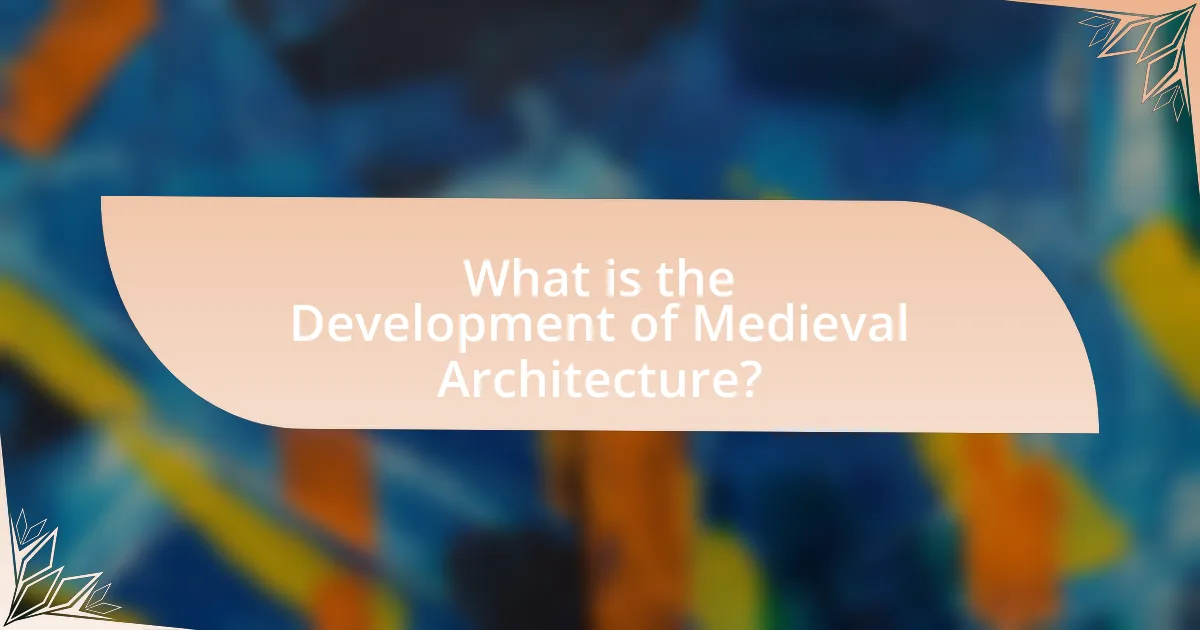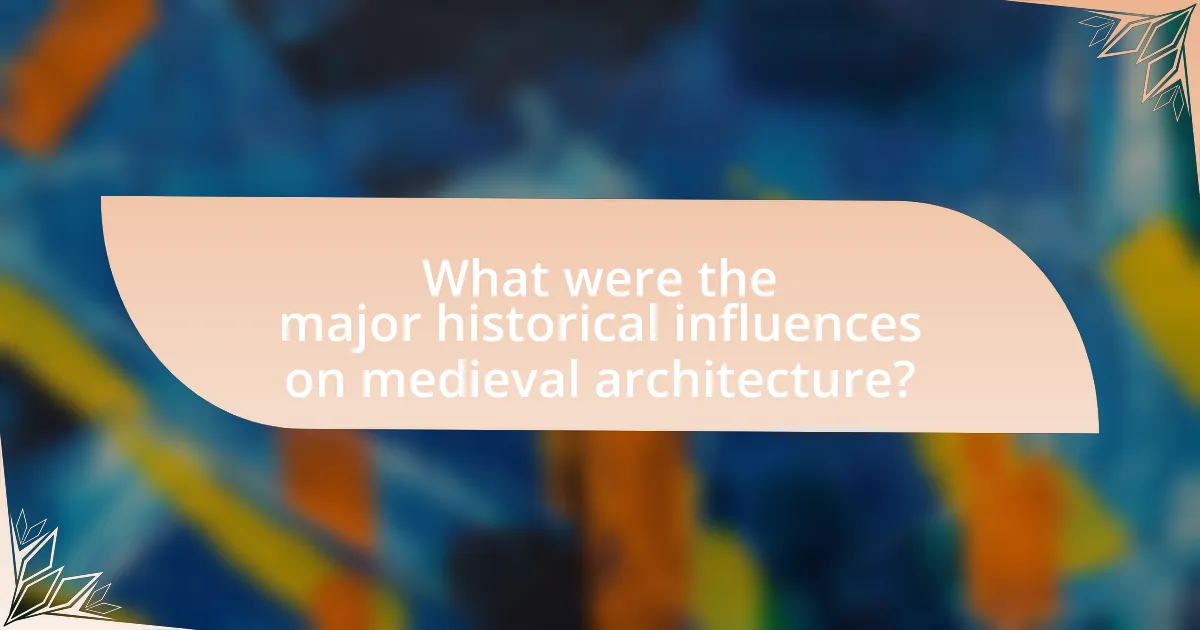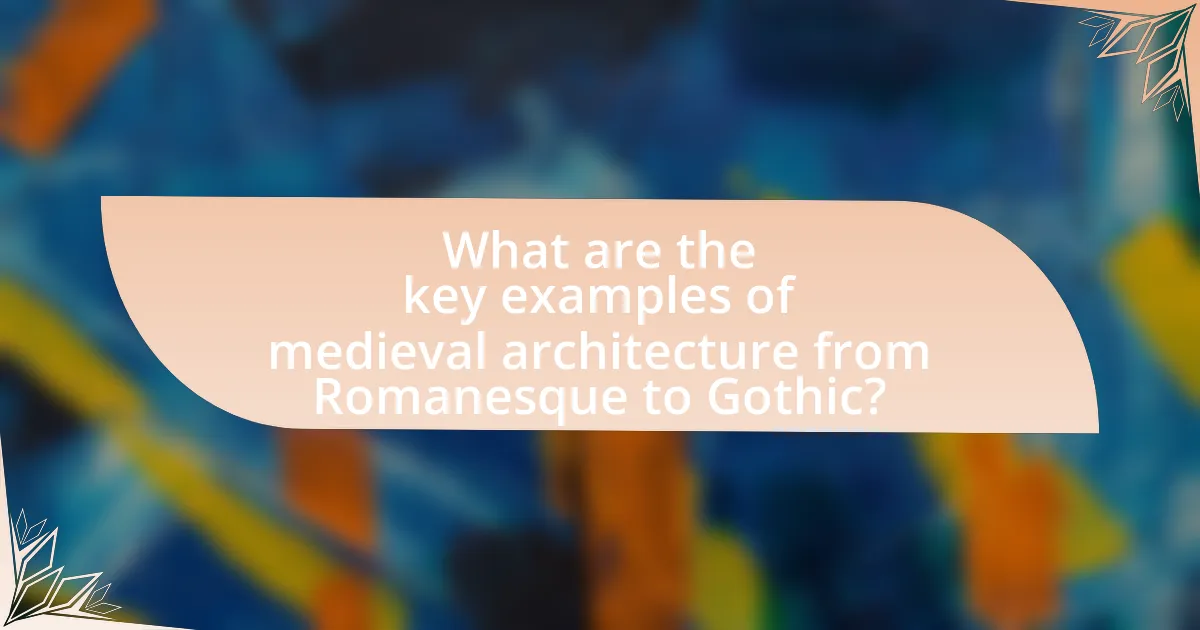The article focuses on the development of medieval architecture, specifically the transition from Romanesque to Gothic styles. It outlines the key characteristics of Romanesque architecture, such as thick walls and rounded arches, and how these elements influenced the emergence of Gothic architecture, which introduced innovations like pointed arches and flying buttresses. The article also discusses the cultural and religious contexts that shaped these architectural styles, notable examples of structures from both periods, and the technological advancements that facilitated this evolution. Additionally, it highlights the significance of these architectural developments in reflecting the values and social hierarchies of medieval society.

What is the Development of Medieval Architecture?
The development of medieval architecture encompasses the transition from Romanesque to Gothic styles, characterized by significant advancements in structural design and aesthetics. Romanesque architecture, prevalent from the 9th to the 12th centuries, featured thick walls, rounded arches, and small windows, emphasizing solidity and fortification. In contrast, Gothic architecture emerged in the 12th century and flourished until the 16th century, introducing innovations such as pointed arches, ribbed vaults, and flying buttresses, which allowed for taller structures and larger windows filled with stained glass. This evolution reflects a shift towards greater lightness and verticality, exemplified by iconic cathedrals like Notre-Dame de Paris and Chartres Cathedral, which showcase the intricate details and grandeur of the Gothic style.
How did Romanesque architecture influence the development of medieval architecture?
Romanesque architecture significantly influenced the development of medieval architecture by introducing structural innovations and aesthetic principles that laid the groundwork for Gothic architecture. Key features such as the use of rounded arches, thick walls, and barrel vaults became foundational elements in subsequent architectural styles. The emphasis on monumental stone construction and the incorporation of decorative elements like sculptural reliefs and intricate capitals in Romanesque buildings set a precedent for the more elaborate designs seen in Gothic cathedrals. Additionally, the Romanesque focus on creating large, unified spaces within churches facilitated the transition to the expansive interiors characteristic of Gothic architecture, which further developed these concepts through the use of flying buttresses and ribbed vaults.
What are the key characteristics of Romanesque architecture?
Romanesque architecture is characterized by its use of semi-circular arches, thick walls, and sturdy pillars. These features provide structural support and create a sense of solidity and permanence. Additionally, Romanesque buildings often include barrel vaults and groin vaults, which allow for expansive interior spaces. The style is also marked by decorative arcading and the use of large, often small windows, resulting in dimly lit interiors. The period, spanning roughly from the 9th to the 12th centuries, reflects a transition from the Roman architectural traditions to the more ornate Gothic style that followed.
How did Romanesque architecture reflect the cultural and social context of its time?
Romanesque architecture reflected the cultural and social context of its time by emphasizing stability, community, and religious devotion. This architectural style, prevalent from the 10th to the 12th centuries, featured thick walls, rounded arches, and sturdy construction, symbolizing the feudal society’s need for security and permanence. The prominence of churches and monasteries in Romanesque architecture illustrated the central role of the Christian faith in daily life, as these structures served not only as places of worship but also as community gathering spaces. Additionally, the use of sculptural decoration on façades and capitals conveyed biblical narratives, reinforcing the church’s authority and educating a largely illiterate population. Thus, Romanesque architecture served as a physical manifestation of the era’s social hierarchies and religious values.
What role did Gothic architecture play in the evolution of medieval architecture?
Gothic architecture significantly transformed medieval architecture by introducing innovative structural techniques and aesthetic elements. This architectural style, which emerged in the 12th century, utilized features such as pointed arches, ribbed vaults, and flying buttresses, allowing for taller and more light-filled structures compared to the preceding Romanesque style. The incorporation of these elements not only enhanced the stability and height of buildings but also facilitated the creation of expansive stained glass windows, which became a hallmark of Gothic cathedrals. Notable examples include the Notre-Dame Cathedral in Paris and Chartres Cathedral, which exemplify the shift towards verticality and luminosity in medieval architecture. This evolution marked a departure from the heavy, solid forms of Romanesque architecture, thereby influencing subsequent architectural developments throughout the late Middle Ages and beyond.
What are the defining features of Gothic architecture?
The defining features of Gothic architecture include pointed arches, ribbed vaults, flying buttresses, and large stained glass windows. Pointed arches allow for greater height and stability, while ribbed vaults enable the construction of complex ceiling designs. Flying buttresses support the walls from a distance, allowing for thinner walls and larger windows. The extensive use of stained glass windows not only enhances the aesthetic appeal but also fills interiors with natural light, creating a spiritual atmosphere. These elements collectively distinguish Gothic architecture from its Romanesque predecessors, which featured rounded arches and heavier structures.
How did Gothic architecture differ from Romanesque architecture?
Gothic architecture differed from Romanesque architecture primarily in its structural elements and aesthetic features. Gothic architecture, which emerged in the 12th century, introduced innovations such as pointed arches, ribbed vaults, and flying buttresses, allowing for taller structures and larger windows. In contrast, Romanesque architecture, prevalent from the 9th to the 12th century, utilized rounded arches, thick walls, and small windows, resulting in a more solid and fortress-like appearance. The use of stained glass in Gothic cathedrals, exemplified by Notre-Dame de Paris, further distinguished it by enhancing interior light and color, a feature less prominent in Romanesque buildings.

What were the major historical influences on medieval architecture?
The major historical influences on medieval architecture include the Roman architectural legacy, the rise of Christianity, and the socio-political changes of the time. Roman architecture provided foundational techniques such as the arch, vault, and concrete construction, which were adapted and evolved during the medieval period. The establishment of Christianity as a dominant religion led to the construction of cathedrals and churches, emphasizing verticality and light, particularly evident in Gothic architecture. Additionally, the feudal system and the growth of towns influenced architectural styles, as castles and fortified structures became necessary for defense and governance. These influences collectively shaped the transition from Romanesque to Gothic architecture, characterized by increased height, elaborate ornamentation, and the use of flying buttresses.
How did religion shape the development of medieval architecture?
Religion significantly shaped the development of medieval architecture by dictating the design, scale, and purpose of structures, primarily through the construction of cathedrals and churches. The Christian faith emphasized the importance of monumental buildings to inspire awe and facilitate worship, leading to the creation of grand structures like the Notre-Dame Cathedral in Paris, which exemplifies Gothic architecture with its soaring spires and intricate stained glass. Additionally, the Church’s influence extended to architectural innovations, such as the use of flying buttresses, which allowed for higher ceilings and larger windows, enhancing the spiritual experience of light and space within these sacred spaces. The period from Romanesque to Gothic architecture reflects this religious motivation, as seen in the transition from the solid, fortress-like Romanesque churches to the ethereal and vertical Gothic cathedrals, illustrating the evolving relationship between faith and architectural expression.
What types of religious buildings were prominent during the medieval period?
During the medieval period, prominent types of religious buildings included cathedrals, monasteries, and churches. Cathedrals, such as Notre-Dame de Paris, exemplified the Gothic architectural style with features like pointed arches and ribbed vaults, which emerged in the 12th century. Monasteries, including the Abbey of Cluny, served as centers of religious life and learning, often showcasing Romanesque architecture characterized by thick walls and rounded arches. Additionally, smaller parish churches were widespread, reflecting local styles and community needs. These buildings not only served spiritual purposes but also represented the socio-political power of the Church during this era.
How did the Church influence architectural styles and techniques?
The Church significantly influenced architectural styles and techniques by promoting the construction of large cathedrals and churches, which necessitated innovations in design and engineering. This influence is evident in the transition from Romanesque to Gothic architecture, where the Church’s emphasis on verticality and light led to the development of pointed arches, ribbed vaults, and flying buttresses. These architectural features allowed for taller structures with larger windows, exemplified by cathedrals like Notre-Dame de Paris, completed in the 12th century, which showcased the Church’s role in shaping the aesthetic and structural advancements of the period.
What impact did technological advancements have on medieval architecture?
Technological advancements significantly transformed medieval architecture by enabling the construction of larger and more complex structures. Innovations such as the pointed arch, ribbed vault, and flying buttress allowed for greater height and stability in buildings, particularly evident in Gothic cathedrals like Notre-Dame de Paris, completed in the 14th century. These advancements facilitated the use of stained glass windows, which enhanced interior lighting and artistic expression, marking a departure from the more solid and less illuminated Romanesque style. The introduction of new materials, such as lighter stone and improved mortar, further supported these architectural innovations, leading to a distinct evolution in the design and functionality of medieval structures.
What construction techniques were developed during the medieval period?
During the medieval period, key construction techniques included the use of ribbed vaults, flying buttresses, and pointed arches. Ribbed vaults allowed for the distribution of weight more effectively, enabling the construction of larger and more complex ceilings. Flying buttresses provided external support to walls, allowing for higher structures and the incorporation of large stained glass windows. Pointed arches facilitated the construction of taller and more stable structures, which became a hallmark of Gothic architecture. These techniques collectively transformed architectural design, leading to the iconic cathedrals and churches of the era, such as Notre-Dame de Paris, which exemplifies these advancements.
How did materials used in construction evolve from Romanesque to Gothic architecture?
Materials used in construction evolved significantly from Romanesque to Gothic architecture, primarily through the increased use of pointed arches, ribbed vaults, and flying buttresses, which allowed for lighter structures and larger windows. Romanesque architecture predominantly utilized thick stone walls and small windows, limiting light and height. In contrast, Gothic architecture embraced innovations such as the use of lighter materials like limestone and the introduction of stained glass, which not only enhanced aesthetic appeal but also allowed for greater structural height and luminosity. The transition is evidenced by the construction of notable Gothic cathedrals, such as Notre-Dame de Paris, which exemplified these advancements through its soaring ceilings and expansive stained glass windows, marking a clear departure from the heavier, more solid forms of Romanesque buildings.

What are the key examples of medieval architecture from Romanesque to Gothic?
Key examples of medieval architecture from Romanesque to Gothic include the Abbey Church of Saint-Savin in France, which showcases Romanesque features such as thick walls and rounded arches, and the Notre-Dame Cathedral in Paris, a quintessential Gothic structure characterized by its pointed arches, ribbed vaults, and flying buttresses. The transition from Romanesque to Gothic is evident in the evolution of architectural elements, with Romanesque buildings emphasizing solidity and mass, while Gothic architecture introduced verticality and lightness, as seen in the Chartres Cathedral, known for its stunning stained glass and intricate façade. These examples illustrate the significant architectural advancements during the medieval period, marking a shift in design philosophy and structural techniques.
What are some notable Romanesque structures and their significance?
Notable Romanesque structures include the Abbey of Saint-Savin, the Cathedral of Pisa, and the Basilica of Saint-Sernin. The Abbey of Saint-Savin, located in France, is significant for its extensive frescoes and architectural innovation, showcasing the use of barrel vaults and thick walls. The Cathedral of Pisa, known for its iconic Leaning Tower, exemplifies the Romanesque style through its use of rounded arches and decorative arcading, reflecting the era’s emphasis on monumental architecture. The Basilica of Saint-Sernin in Toulouse is important for its size and design, serving as a pilgrimage church and demonstrating the Romanesque focus on verticality and spatial organization. These structures collectively highlight the transition from Roman architectural traditions to the more elaborate Gothic style that followed.
How do specific Romanesque buildings exemplify the style?
Specific Romanesque buildings exemplify the style through their characteristic features such as rounded arches, thick walls, and barrel vaults. For instance, the Abbey of Saint-Savin in France showcases these elements with its extensive use of barrel vaulting and decorative frescoes, which highlight the emphasis on solidity and simplicity typical of Romanesque architecture. Additionally, the Pisa Cathedral in Italy demonstrates the style through its robust structure and the use of columns and arches, reflecting the Roman influence and the focus on horizontal lines. These buildings collectively illustrate the Romanesque style’s focus on functionality, durability, and a sense of monumental presence, which were essential in the architectural developments of the medieval period.
What historical events are associated with these Romanesque structures?
Romanesque structures are associated with several historical events, primarily the rise of monasticism and the establishment of pilgrimage routes during the 10th to 12th centuries. The construction of these buildings coincided with the spread of Christianity across Europe, leading to the establishment of significant religious sites such as the Abbey of Cluny in France, which became a center for monastic reform. Additionally, the Crusades, beginning in 1096, spurred architectural developments as churches and cathedrals were built to accommodate the influx of pilgrims. The architectural style itself reflects the socio-political stability of the time, allowing for large-scale construction projects that symbolized the power of the Church and the feudal system.
What are the most famous Gothic cathedrals and their architectural features?
The most famous Gothic cathedrals include Notre-Dame de Paris, Chartres Cathedral, and Cologne Cathedral, each showcasing distinct architectural features. Notre-Dame de Paris is renowned for its flying buttresses, ribbed vaults, and intricate rose windows, which enhance both structural stability and aesthetic appeal. Chartres Cathedral is celebrated for its remarkable stained glass windows and its well-preserved façade, featuring a blend of Romanesque and Gothic styles, along with its iconic spires. Cologne Cathedral, one of the tallest cathedrals in Europe, is distinguished by its elaborate façade, pointed arches, and extensive use of flying buttresses, which exemplify the height and light characteristic of Gothic architecture. These cathedrals collectively illustrate the evolution of architectural techniques and artistic expression during the Gothic period, emphasizing verticality, light, and intricate detailing.
How do these Gothic cathedrals reflect the values of their time?
Gothic cathedrals reflect the values of their time by embodying the spiritual aspirations, social hierarchy, and technological advancements of the medieval period. These structures, characterized by their soaring spires, intricate stained glass, and ribbed vaults, symbolize the era’s emphasis on the divine and the importance of the Church in daily life. The height and light of Gothic architecture were intended to inspire awe and elevate the human spirit towards God, aligning with the medieval belief in the centrality of faith. Additionally, the construction of these cathedrals often involved the collaboration of various social classes, showcasing the communal effort and the growing influence of urban centers during the period. Historical examples, such as Notre-Dame de Paris, illustrate how these buildings served not only as places of worship but also as symbols of civic pride and identity, reflecting the values of community and devotion prevalent in the 12th to 16th centuries.
What innovations in design can be seen in these Gothic structures?
Gothic structures exhibit several key innovations in design, including the use of pointed arches, ribbed vaults, and flying buttresses. Pointed arches allowed for greater height and more complex designs, enabling the construction of taller and more slender structures. Ribbed vaults provided a framework that distributed weight more efficiently, allowing for larger interior spaces and intricate ceiling designs. Flying buttresses, which transferred the weight of the roof and walls outward, permitted the inclusion of expansive stained glass windows, enhancing both the aesthetic and spiritual experience within these buildings. These innovations collectively marked a significant evolution from the earlier Romanesque style, characterized by heavier, round arches and solid walls.
What lessons can be learned from the development of medieval architecture?
The development of medieval architecture teaches the importance of innovation in structural engineering and aesthetic expression. For instance, the transition from Romanesque to Gothic architecture illustrates how advancements such as the pointed arch, ribbed vault, and flying buttress allowed for taller structures and larger windows, enhancing both stability and light within cathedrals. Notable examples include the Notre-Dame Cathedral in Paris, which showcases these innovations, reflecting the era’s technological progress and artistic aspirations. This evolution highlights how architectural design can respond to cultural and functional needs, influencing future architectural practices.
How can modern architecture draw inspiration from medieval styles?
Modern architecture can draw inspiration from medieval styles by incorporating elements such as pointed arches, ribbed vaults, and intricate stone carvings. These features, prominent in Gothic architecture, can enhance the aesthetic appeal and structural integrity of contemporary buildings. For instance, the use of pointed arches allows for greater height and lightness in design, as seen in the works of architects like Jean Nouvel, who integrates these elements into modern structures. Additionally, the emphasis on craftsmanship and local materials in medieval architecture can influence modern sustainable practices, promoting a connection to place and history. This blend of historical techniques with modern innovation creates a dialogue between past and present, enriching architectural expression.
What are the best practices for preserving medieval architectural heritage?
The best practices for preserving medieval architectural heritage include thorough documentation, regular maintenance, and the use of appropriate materials for restoration. Documentation involves creating detailed records of the structure’s history, architectural features, and previous restoration efforts, which aids in informed decision-making. Regular maintenance ensures that minor issues are addressed before they escalate into significant problems, preserving the integrity of the structure. Additionally, using materials that match the original construction, both in composition and appearance, is crucial to maintaining historical authenticity. For instance, the restoration of the Notre-Dame Cathedral in Paris emphasizes the importance of using traditional stone and techniques to preserve its medieval character.